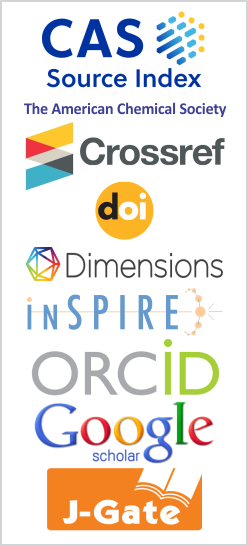Theoretical study of Scattering of Electron Transport
DOI:
https://doi.org/10.26713/jamcnp.v6i3.1289Keywords:
Scattering, Monte Carlo method, Electron transportAbstract
The effect of the scattering-direction of hot electrons in the drain of ballisticDownloads
References
2011 International Technology Roadmap for Semiconductors (2011 ITRS), http://www.itrs2.net/2011-itrs.html.
K. Natori, Scaling limit of the MOS transistor – A ballistic MOSFE, IEICE Trans. Electron. E84-C, 1029 (2001).
P. Palestri, D. Esseni, S. Eminente, C. Fiegna, E. Sangiorgi and L. Slemi, A Monte-Carlo study of the role of scattering in deca-nanometer MOSFETs, IEDM Tech. Dig. 2004, p. 605, DOI: 10.1109/IEDM.2004.1419234.
M. Fischetti and S. Laux, Monte-Carlo study of sub-band-gap impact ionization in small silicon field-effect transistors, IEDM Tech. Dig. 1995, p. 305, DOI: 10.1109/IEDM.1995.499202.
A. Svizhenko and M. P. Anantram, Role of scattering in nanotransistors, IEEE Trans. Electron Devices 50, 1459 (2003), DOI: 10.1109/TED.2003.813503.
T. Kurusu and K. Natori, Numerical study on Ballistic n+-i-n+ diode by Monte Carlo simulation: Influence of energy relaxation of hot electrons in drain region on Ballistic transport, Jpn. J. Appl. Phys. 45, 1548 (2006), DOI: 10.1143/JJAP.45.1548.
T. Gonzalez and D. Pardo, Physical models of ohmic contact for Monte Carlo device simulation, Solid-State Electron. 39, 555 (1996), DOI: 10.1016/0038-1101(95)00188-3.
K. Tomizawa, Numerical Simulation of Submicron Semiconductor Devices, Artech House (1993), https://searchworks.stanford.edu/view/2799273.
C. Jacoboni and L. Reggiani, The Monte Carlo method for the solution of charge transport in semiconductors with applications to covalent materials, Rev. Mod. Phys. 55(3), 645 (1983), DOI: 10.1103/RevModPhys.55.645.
G. Donnarumma, J. Wozny and Z. Lisik, Monte Carlo simulation of bulk semiconductors for accurate calculation of drift velocity as a parameter for drift-diffusion, hydrodynamic models, Mater. Sci. Eng. B 165, 47 (2009), DOI: 10.1016/j.mseb.2009.01.027.
W. Shockley, Currents to conductors induced by a moving point charge, J. Appl. Phys. 9, 635 (1938), DOI: 10.1063/1.1710367.
S. Ramo, Currents induced by electron motion, Proc. IRE 27, 584 (1939), DOI: 10.1109/JRPROC.1939.228757.
H. Kosina, A method to reduce small-angle scattering in Monte Carlo device analysis, Transaction on Electron Devices 46, 1196 (1999), DOI: 10.1109/16.766884.
H. Kosina, Efficient evaluation of ionized-impurity scattering in Monte Carlo transport calculations, Physica Status Solidi A 163, 475 (1997), DOI: 10.1002/1521-396X(199710)163:2%3C475::AID-PSSA475%3E3.0.CO;2-E.
J. Shah, Ultrafast Spectroscopy of Semiconductors and Semiconductor Nanostructures, Springer, Berlin (1998), DOI: 10.1007/978-3-662-03770-6.
K. B. Ridley, Quantum Processes in Semiconductors, Oxford, London (1982).
E. Pop, R. W. Dutton and K. E. Goodson, Detailed heat generation simulations via the Monte Carlo method, in Simulation of Semiconductor Processes and Devices, Boston, MA (2003), p. 121, DOI: 10.1109/SISPAD.2003.1233652.
Downloads
Published
How to Cite
Issue
Section
License
Authors who publish with this journal agree to the following terms:- Authors retain copyright and grant the journal right of first publication with the work simultaneously licensed under a CCAL that allows others to share the work with an acknowledgement of the work's authorship and initial publication in this journal.
- Authors are able to enter into separate, additional contractual arrangements for the non-exclusive distribution of the journal's published version of the work (e.g., post it to an institutional repository or publish it in a book), with an acknowledgement of its initial publication in this journal.
- Authors are permitted and encouraged to post their work online (e.g., in institutional repositories or on their website) prior to and during the submission process, as it can lead to productive exchanges, as well as earlier and greater citation of published work.




